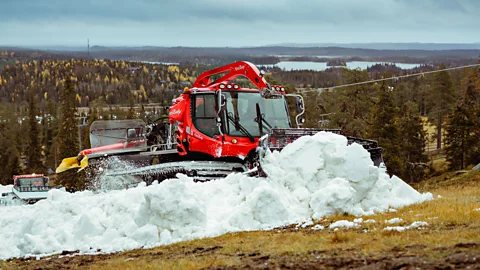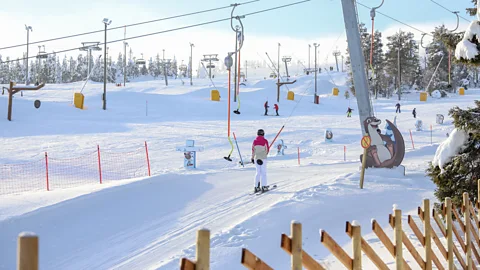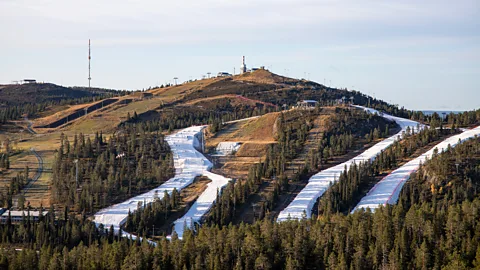The ski resorts saving snow over the summer
By Amanda Ruggeri,Features correspondent

As global warming is threatening ski holidays, some resorts are reviving an ancient trick: saving snow over the summer.
At the ski resort of Ruka, Finland, the snow normally starts to melt in April. In early May, the 22 chairlifts will, temporarily, grind to a halt. The 41 trails will, like every year, turn green – making the hill a destination for hikers and mountain bikers, not skiers.
Five of the trails have been punctuated by two mounds of snow covered in white polystyrene blankets. Each huge mound will hold about 30,000 cubic metres (1.05 million cubic ft) of snow. They will stay there throughout the summer. When these mounds are uncovered in October, according to data estimates based on past years, some 80 to 90% of the snow will remain, enough to spread across three or four downhill slopes, plus the snow park.
For a low-altitude resort like Ruka, which doesn't quite reach 500m (1,650ft), this isn't just convenient. It's game-changing – particularly in the early part of the ski season, when both snow, and temperatures, can be variable. "About 10 years ago, we could guarantee good snow conditions from early December until April. Now, with snow farming, we can guarantee good ski conditions from early October until the second week of May," says Antti Karava, CEO of Ruka and Pyha Ski Resorts.
 Veera Vihervaara/Ruka
Veera Vihervaara/Ruka
As winters warm and snowfall becomes less predictable, ski resorts are having to come up with novel ways to protect snow (Credit: Veera Vihervaara/Ruka)
As winters warm and snowfall becomes less predictable, dozens of ski resorts around the world are turning to variations of a technique alternatively called "snow farming" or "snow storage". Snow produced over the winter is pushed together, covered with insulation, and left throughout the summer. In the autumn, ahead of the season opening or an event like a ski race, the snow is uncovered and pushed to where it needs to go.
In some ways, this practice is more efficient than traditional snow-making. And it can be hugely beneficial for both resorts like Ruka and their local economies, those in the industry say. Visitors aren't likely to book a holiday to come ski unless they can depend on snow cover, and major ski races that draw thousands of tourists might have to be cancelled. But, experts say, that resorts are having to turn to technologies like snow storage also underscores a real flaw with skiing's carbon footprint – the industry's reliance on a traditional "season" that starts as early as October, despite autumn snow cover being increasingly rare.
You can make it resistant to the heat around it if you insulate it well – Fabian Wolfsperger
That snow can be stored year-round might seem surprising, but the practice dates back centuries. Before refrigeration, people stored ice and snow underground during the summer to allow them to keep food cool, for example. In more recent decades, as the ski industry has experimented with ways to preserve snow to allow for autumn or early-winter events or openings, resorts have piled snow together, then covered the piles with an organic material like sawdust, chipped wood, or straw. These methods can be surprisingly effective: One research paper found that they could preserve between 72-85% of snow mass over the summer.
"It's like a house. You can have a warm house even in Arctic conditions if you insulate it well. The same, the other way around, with a heap of snow – you can make it resistant to the heat around it if you insulate it well," says Fabian Wolfsperger, head of the Snow Sports Lab at Switzerland's Institute for Snow and Avalanche Research and one of the paper's co-authors.
Today, however, the technology is far more advanced. Finnish company Snow Secure's system, for example, includes white, polystyrene blankets, either 50 or 70mm (2in to 2.8in) thick, designed to fit precisely shaped geometric mounds of snow.
According to the company's own tests, the system works even in the hottest of temperatures. Over the course of a week in June 2023 in Vihti, Finland, temperature measurements taken from the top of the blanket covering stored snow showed a maximum temperature of 44C (111F). (The maximum air temperature was 31C (87.8F)). Below the mat? The temperature only reached a maximum of 2.5C (37.5F).
 Jani Kärppä/Ruka Ski Resort
Jani Kärppä/Ruka Ski Resort
The blankets stop the snow from melting when when the temperature rises during the summer (Credit: Jani Kärppä/Ruka Ski Resort)
While some 90% of the snow gets saved this way, the idea isn't to store enough snow to cover an entire resort. Instead, it might cover a slope that acts as a key artery, for example between two main chairlifts, or a snow park or children's area.
And, of course, many already choose to cover any slope being used for a competition. One of the best-known, and most successful, examples of this has been Levi, Finland, which hosts the first slalom races of the FIS Alpine Ski World Cup calendar every November. Since 2016, Levi has used snow storage to ensure those slopes will be ready for racing. In the years since, Levi hasn't once cancelled a slalom race due to lack of snow, unlike many of the other resorts hosting autumn FIS races.
Of course, even this comes at a price. A Snow Secure pilot costs about €50,000 to €100,000 (£43,000 to £87,000) while for enough snow to cover a whole slope, it's "several hundreds of thousands", says Lauslahti. It is, he says, an investment: over 10 years, the cost comes out to less than €1 (87p) per cubic metre of snow.
There's also an environmental cost – though it might be less than the way many resorts currently ensure adequate snow cover.
With snow storage, resorts like Ruka can focus on the most efficient times to make snow
Many resorts depend on artificial snow-making. But how much snow they can make depends on the conditions. When there's a combination of very cold temperatures, dry air, and mild winds, the process is the most efficient. If temperatures are around -2C (28F), for example, says Karava, a snow gun can go through about two cubic metres (71 cubic ft) of water per hour, producing three cubic metres (105 cubic ft) of snow. But if the temperature is between -15C and -20C (5 to -4F), a snow gun can go through 20 cubic metres of water (700 cubic ft) per hour – and produce 35-40 cubic metres (1,236-14-12 cubic ft) of snow. "So it's 10 times more snow, with the same amount of energy," he says.
But many resorts still try to make snow whenever they can. That includes the least efficient time of all – in October or November, when many of them are most desperate to get coverage ahead of opening, but the weather may still be relatively warm.
With snow storage, resorts like Ruka can focus on the most efficient times to make snow, such as in January, instead, says Karava.
But it's still a process that requires energy, cautions Wolfsperger. "Clearly there's a carbon footprint," he says. In fact, he says, snow farming can even require two or three times more energy than traditional snowmaking, thanks to needing to distribute the snow. "As long as those machines drive with fossil fuels, this is an additional footprint," Wolfsperger says. (At Ruka, Karava notes, the grooming machines are run with renewable diesel, which cuts the process's carbon footprint by about 90%).
 Tomi Turunen/Ruka Ski Resort
Tomi Turunen/Ruka Ski Resort
How much snow resorts can produce themselves depends on how cold it is; the colder the air, the more snow can be created (Credit: Tomi Turunen/Ruka Ski Resort)
Of course, Wolfsperger says, "it's always a question of what you're comparing to". If you're comparing the process to a resort trying to make snow in the warmer days of autumn, for example, it might indeed be more energy efficient.
But there are other options. "If you say, 'Why don't we shift the World Cup to four weeks later', you'd save energy," he says.
This is something that the International Ski and Snowboard Federation (FIS), for one, seems to be increasingly aware of. The FIS World Cup alpine ski calendar starts in October and ends in March. But that's become an almost impossible schedule to maintain. This season, eight of the first 11 races on the men's calendar across locations in Austria, Switzerland, Canada and the US were cancelled, mostly due to poor conditions. Last season was much the same.
The current FIS schedule – and the traditional ski season, in general – doesn't make much sense today, Wolfsperger points out. "Snow is a material which accumulates during the season," he says. At many mountains, that means there's little to none in December – even though that's when many resorts are preparing for one of their biggest tourism weeks of the calendar, the Christmas holidays.